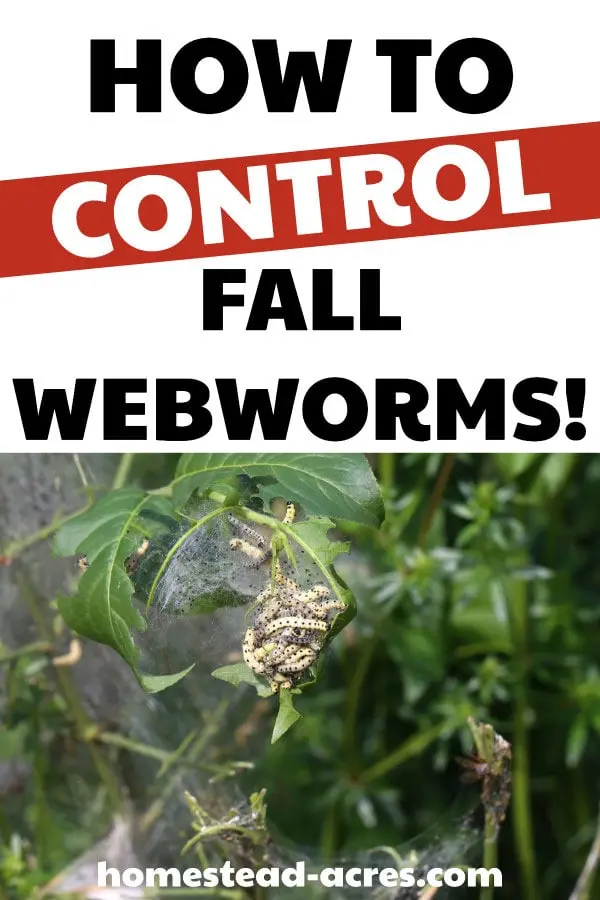This post may contain affiliate links, my full disclosure can be read here. As an Amazon Associate I earn from qualifying purchases.
Are you surprised to see large web-like nests covering your trees? These are called fall webworms and can really make your trees look messy! But don’t worry there are easy ways to control fall webworms so you can keep your trees looking great.
In the late summer too early fall you may start noticing large, sack-like webs covering the branches of trees.
These are fall webworm nests often confused with tent caterpillars that appear earlier in the season.

What Are Fall Webworms?
Fall webworms (Hyphantria cunea) are caterpillars of the Drury moth in the Erebidae family. They are native to North America and can be found from Canada to Mexico.
Webworms were introduced into Yugoslavia in the 1940s and have spread throughout Europe and Asia.
They can be a real pest especially if you grow fruit and nut trees that are to be harvested in the fall. But fall webworm control isn’t as difficult as you might think.
Life cycle

In northern areas of North America, there is 1 generation of webworms each year and can be seen in the late summer too early fall.
In the south, there can be 2 or more generations per year and they start to appear earlier in the year.
The female moth lays her eggs on the underside of tree leaves in clusters that contain hundreds of eggs. They hatch about a week after laying.
The caterpillars can range in color from pale yellow to dark grey and have 2 rows of small black spots along their back.
As they grow they develop yellow stripes running along their sides. They have patches of long and short bristles that grow out of the black spots and get larger as they grow.
Webworms can have red or black heads depending on the variety.
They start out very small but can grow to be about 1 inch long.
They feed on tree leaves for 4-6 weeks before falling to the ground to find a place to overwinter.
The caterpillars pupate and overwinter in the leaf litter at the base of trees. The cocoons are a dark brown color and about .39 inches (10 mm) long.
In late May to June, the adult moths emerge from the cocoons and the cycle starts all over again.
Fall Webworm VS Tent Caterpillars

Webworms are often confused with tent caterpillars but are actually caterpillars of different moths.
Tent caterpillars are also active in the spring and mid-summer but webworms are found in the late summer to early fall.
Tent caterpillars make nests in the forks of tree branches and they are compact and neat looking. Webworms, on the other hand, make much larger nests that look quite messy.
Unlike tent caterpillars, webworms also make their nests around branches containing leaves. This lets the larva feed safely inside the nests until a later instar (growth stages).
What Do Fall Webworms Eat?
Fall webworms feed on the leaves of nearly any type of deciduous tree. In large outbreaks, they can defoliate the entire tree.
Some of their favourite trees to feed on are:
- Alder
- Apple
- American Elm
- Birch
- Cherry
- Cottonwood
- Crabapple
- Maple
- Pecan
- Peach
- Pear
- Walnut
- Willow
Do Fall Webworms Kill Trees?
No, normally webworms feeding on trees doesn’t do permanent damage. They start feeding late in the growing season just before the tree leaves normally start changing color and falling off anyway.
The trees will just grow back new leaves in the spring.
But young trees can be more easily damaged and completely defoliated by webworms. If you see them in your younger trees that haven’t been established yet it’s a good idea to get rid of them.
How To Get Rid Of Fall Webworms

If you just have a few webworm nests and they are up high in your tree it might be easiest to just leave them be. The nest will fall apart overwinter naturally.
Although burning the nests is a common way of dealing with them it’s really unsafe for both the tree and you. It damages the tree branches, can cause fires and you can be seriously hurt.
If they are in reach then there are a few easy ways to get rid of webworms in your trees and shrubs.
1. Break Open The Nests
Break the nests apart using a stick or long pole. You can simply poke holes into the nest or twist the pole to remove the webs.
While webworms are inside of the next they are protected from predators. By breaking the nest’s open birds, wasps and other natural predators can reach them.
2. Use BTK
BTK ( Bacillus thuringiensis) is a natural bacteria that kills caterpillars including webworms. It won’t cause damage to plants, people, birds, or bees.
Since this type of caterpillar feeds inside its web, it’s most effective if you can break a hole in the web and spray it on to the caterpillars and leaves inside the web.
3. Spray With Neem
Neem oil is a great organic insecticide and very effective at getting rid of caterpillars. But remember to use it with care because it will also kill beneficial insects.
4. Vegetable Oil
Vegetable oil is a cheap and easy way to kill caterpillars and it can soak right through most caterpillar webbing too. Simply fill a spray bottle with vegetable oil and coat the nest well.
Do take care that spraying any oil onto plant leaves can cause damage, especially if the plant is in the sun. This can be a problem since webworms cover an entire branch including leaves with their nest. So try a test area first or try the next method.
5. Dish Soap
One of the easiest ways to get rid of fall webworms is to simply use dish soap and water.
Mix 2 to 3 tablespoons of dish soap to 1 gallon of water in a sprayer. Make sure to add the dish soap after filling the sprayer with water because you don’t want it to suds up.
Then give the sprayer a gentle shake to mix up the soap and water. You can reach quite high into most trees with hand sprayers.
But using a hose-end sprayer canister works really well too. Just set it for 1 oz per gallon and use a sharp stream. This can reach 20 to 30 feet, plenty high enough to spray most nests.
Natural Predators
- Birds
- Yellow Jackets
- Parasitic Wasps
- Ladybugs (Coleomegilla maculata)
- Little Black Ants (Monomorium minimum)
As with all pests, it’s easier to get rid of fall webworm caterpillars when they first start appearing in your trees. So keep a close eye out starting in the late summer for white cobweb looking nests in your trees and shrubs.
Then uses the easy tips shared here to get rid of the webworms before the nests get large enough to cover your trees.
Connect With Homestead Acres!
Be sure to follow me on social media, so you never miss a post!
Facebook | Twitter | Pinterest | Twitter
Visit my Amazon store to find all my favorite gardening, homesteading tools, and gadgets plus all of my printed garden books and journals!

Kim Mills is a homeschooling mom of 6 and lives on an urban homestead in Ontario, Canada. Blogging at Homestead Acres she enjoys sharing tips to help you save money, grow and preserve your own food.




Tina Jeffers
Thursday 19th of August 2021
I have Fall webworms crawling and climbing all over my back porch. There are hundreds of them. Some I have found in my house crawling across my floor. What do I do?
Dianne
Monday 21st of September 2020
Thank you for the tips. I've had something drilling into my green tomatoes. UGH. This is the first year that's happened. I can't find anything on the plants though. So far, I've found three tomatoes like that. I've been removing them and giving the tomatoes to my chickens. I figure whatever is in them the chickens will find. Any idea of what it is?
Briana
Wednesday 16th of October 2019
I stumbled across your website because I have these pests on a plant and I tried the simple soap method and am already seeing results. Thank you. I’m also a homeschool mom and can’t wait to check out the rest of your site.
Jenn
Tuesday 2nd of July 2019
Very interesting! Helpful too! We have the tent caterpillars, I just read today about cutting open the nest so the predators can get them. We usually climb up and pull it all down into a bucket of soapy water. May have to try some of your tips if we get them too badly!